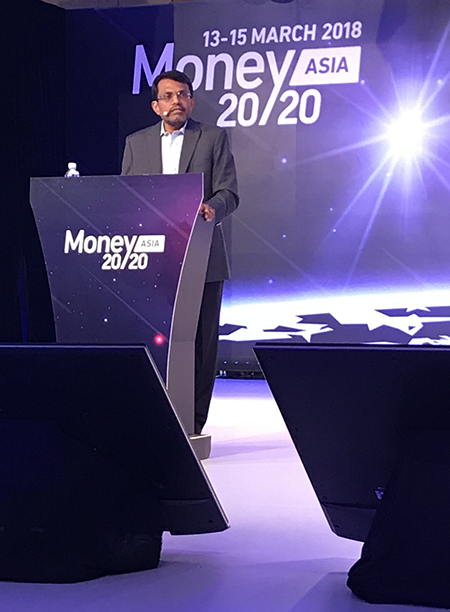
Volatility in the price of bitcoin and potential scams in crypto fundraising schemes overshadow legitimate ecosystem developments.
Speakers and panelists at Day 3 of Money20/20 Asia brought greater clarity to the present and future of the emerging “crypto economy” and its controversial components. In my mind, definitions of the terms are becoming more exact and distinct:
Cryptocurrency. Used initially to describe bitcoin, which was designed as a currency, a medium of monetary exchange. Refers generally to digital currencies secured by cryptography for payments.
Crypto-token. Used initially to distinguish between bitcoin and Ethereum, a network of “smart contracts” or applications designed to extend beyond currency functions. Refers to the bit of cryptographic code that represents and expresses the ownership and value of an application or asset
Cryptoasset. Used to refer to any asset represented cryptographically in the form of a crypto-token. Assets represented in this way are said to be “tokenized.”
The future of tokenized fundraising
“It’s the tokenization of the asset that’s the revolution,” said Dave Birch, director of innovation, Consult Hyperion, a London-area consultancy that specializes in secure transactions. Birch interviewed corporate venture-capital manager Jonathan Larsen at Money20/20 Asia.
“Tokenization is a really massive trend,” Larsen said. “That’s a much bigger story that cryptocurrencies, initial coin offerings (ICOs), and even blockchain.” Larsen is chief innovation officer of Ping An Group and head of the Ping An Global Voyager Fund. Ping An is a Chinese financial-services holding group based in Shenzhen.
“I have no doubt about the opportunities (of tokenization) to reduce friction across every asset class and to create fractionalization of assets where it does not exist today,” he said. Fractionalization refers to the ability to, for instance, partition the equity you own in a home and use the resulting token to sell that equity as a tradable asset.
“That means if you own a home and if you could use tokens to express the equity in your home, you could sell that equity or use it as collateral in a much easier way than our current paper-based processes,” Larsen explained. As another example, aggregate insurance risks could also be traded more easily and broadly than through the traditional reinsurance companies that cover those risks for insurers.
“We can create transparency and universal access and the ability to reduce frictional costs,” Larsen said. “Tokenization is at the core.”
“It leads to more efficient and liquid markets,” Birch said.
Asset-backed crypto-tokens
The difference to understand between tokens and ICOs is that tokens are based on verifiable assets. ICOs are the sale of tokens representing an ownership stake in a firm or application—investment offerings for all practical purposes and likely to be regulated as such by U.S. securities regulators.
“ICOs are tokens minus the assets,” quipped Larsen. “Where we are going is tokens with assets and solving the problems of friction (in markets). . . . ICOs are the training wheels for the token economy.”
At this point, however, creating tokens based on real assets is not easy, according to Henri Arslanian PwC’s FinTech and RegTech lead for China and Hong Kong. He reported on work his firm is doing on asset-backed crypto-tokens. “In practice, it’s extremely difficult not only from a tax perspective compared to a regular currency, but how can you guarantee that it’s actually backed by the asset. What are the guarantees?”
As with any other asset class, standards will need to be developed for governance, audit, and verification. “Right now, none of the Big Four audit crypto,” Arslanian noted.
Central-bank digital currencies
Central bankers are monitoring these technologies with great interest. Several central banks around the world are studying whether and where to issue tokens that represent currencies.
Central-bank digital currencies (CBDCs) fall into two categories:
- Wholesale. Tokens issued for use between banks that settle accounts with one another through the central banks, i.e., interbank settlements.
- Retail. Tokens issued for use general-purpose use by consumers or businesses in place of electronic or paper currency.
For central banks, wholesale tokens have interest for use in improving interbank settlements, though early experiments have not shown sufficient efficiencies. A number central banks have experimented with wholesale tokens.
The Central Bank of Canada did an initial experiment using crypto-tokens for interbank payments in 2016. That work is continuing in an experiment with the Monetary Authority of Singapore (MAS) focused on cross-border settlements, an area that MAS sees as the most promising use of blockchain and tokens by central banks.
MAS currently is testing the efficiencies of blockchain technology, including wholesale tokens, to make interbank payments more efficient. The recently completed Phase 2 of Project Ubin concluded that interbank settlement functions could be decentralized without compromising privacy and run without a central MAS infrastructure.
When it comes to CBDCs (retail tokens), however, MAS is not impressed. “We don’t see an urgent need, and there’s a lot more we can do to make traditional payments much faster, cheaper, and virtually free,” said Ravi Menon, MAS managing director in his Money20/20 Asia closing keynote.
“We already have a faster payments network where we can send money using just a mobile number, and it’s free and instantaneous. So I’m not sure why a central bank would issue crypto when you have that.”
It just isn’t money—yet
Indeed, MAS’s Menon concluded that none of today’s cryptocurrencies meet the criteria to be considered money:
- Means of exchange
- Store of value
- Unit of account
“No crypto-token meets these three criteria in sufficient measure to qualify as money,” Menon said.
The Bank of International Settlements, the central bank to central banks, agreed. “At this time, the general judgment is that their volatile valuations and inadequate investor and consumer protection make them unsafe to rely on as a common means of payment, a stable store of value, or a unit of account,” concluded researchers at the BIS in its latest report on CBDCs, issued last week.
A Money20/20 Asia panel focused on central-bank issued digital currencies, however, focused on several forward-looking use cases for CBDCs, outlined by Xen Baynham-Herd, head of strategy and lead economist at Blockchain:
First, central banks could have greater interest rate control. In an era in which interest rates are close to zero and have been negative, central banks lose control. If interest rates are negative, people hoard cash and arbitrage on the rate. Without cash, rates can be negative.
Central banks could also directly set different rates for different people. Central bank rates are expressed through intermediaries in the real economy, and it does not always work out according to policy. For instance, the credit that was supposed to be granted to small and medium-sized businesses as a result of low interest rates has not been granted at the anticipated scale.
The granularity of transactions can be increased beyond what today’s electronic transactions make possible today. Assets that move off the ledger can be paired with those on the ledger, enabling the bank to account for assets more accurately.
Lastly, CBDCs could make it possible for central banks to implement momentary policy immediately. Rates could be tweaked in real time through a dashboard, rather than setting the rate and waiting a month to set it again.
Yet until the risks of digital currencies themselves are worked out, let alone the risks of potentially granting consumers direct access to a central bank’s balance sheet, retail CBDCs are a long way off.
“We now have no true stable coins that can move value around the world in a way that the value stays constant,” Baynham-Herd said. “A digital native coin backed by an asset to enable value to be stable is the biggest tipping point or enabler for the digital economy.”
In the meantime, central bankers at MAS are watching the development of cryptocurrency trading on regulated exchanges in the United States. “MAS has chosen to date not to regulate crypto tokens directly,” Menon said. “Regulation should not try and front-run innovation. We’re watching closely what’s going on but not getting ahead.”


